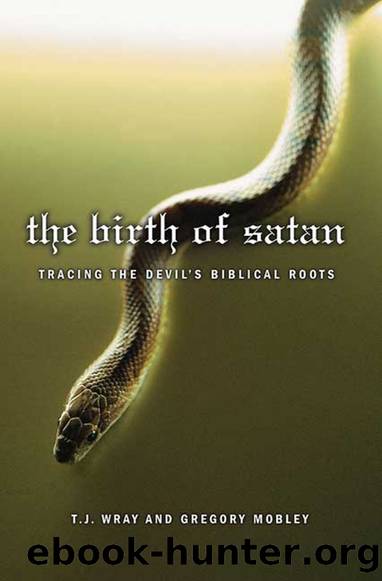The Birth of Satan: Tracing the Devil's Biblical Roots by T.J. Wray

Author:T.J. Wray [Wray, T.J.]
Language: eng
Format: epub
ISBN: 9781466886889
Amazon: B00OO199EY
Barnesnoble: B00OO199EY
Published: 2008-09-29T23:18:23+00:00
chapter 6
satan in
the new testament
The devil can cite scripture for his own purpose!
âWilliam Shakespeare
there was a growing consensus about the existence of a supreme evil being in the Intertestamental Period, but the Prince of Demons had many names. Although these names resurface from time to time in the New Testament, one name emerges above the rest: Satan. It is this name, Satan, that will become the Prince of Demonsâ most popular designation, inducing fear and trembling at its mere mention for generations to come.
Satan assumes a more commanding role in the New Testament, and his demonic minions, in fact, abound in the New Testament (appearing some 568 times), cropping up in unlikely places and challenging the ultimate authority of Jesus. Even though Satanâs character is more clearly defined in the New Testament than it had been in the Hebrew Bible (as we shall soon see, Satan is now the archnemesis of Jesus), his essential function in the Bible remains unchanged: He is still the troublemaker, the stumbling block, the Adversary. However, even as the figure of Satan grows more confident, more powerful, and more insidiousâblatantly challenging Jesusâ authority
114
the birth of satan
and even infiltrating the ranks of those close to himâhe is not allowed to move about in the world unopposed. Indeed, Jesus, the hero of the New Testament, steps forward to confront the villain at every turn. Although the Devil may have a few tricks up his sleeve, the authors of the New Testament make it clear that Satan is no match for the obedient Son of God.
Round after round hero and villain spar in a struggle for universal su-premacy, but at the end of the struggle, God scores a knockout, throwing Satan into a âlake of fire and sulfurâ (Rev 20:10).
As we have pointed out, belief in a demonic being called Satan evolved only over a long period of time. Several factors influenced this development, including the religious syncretism of the ancient Near East, the foreign domination of Palestine, the increased reflection about the origins of evil on behalf of Jews in the Second Temple period (538 B.C.E.â70 C.E.), and Jewish apocalyptic thinking. When the Babylonians razed the First Temple in Jerusalem in 587 B.C.E., they also unwittingly destroyed the efficacy of the Iron Age theology that equated punishment, measure for measure, with sin.
We need to keep in mind the precarious world into which Jesus of Nazareth is born. The destruction of Solomonâs Temple (the First Temple) and the exile of many of Jerusalemâs citizens, combined with the continued indignities of colonial life, inspired speculations about possible sources of evil that were more sinister and powerful than prophetic finger-pointing could account for. Evil seemed to be more than the inevitable consequences of human sin; it seemed to have a life of its own. Jesusâ life is sandwiched between two important struggles for Judean independence: the successful Jewish rebellion against Antiochus IV (142 B.C.E.) and the unsuccessful Jewish rebellion against Rome that resulted in the destruction of Judea (66â73 C.E.).
Download
This site does not store any files on its server. We only index and link to content provided by other sites. Please contact the content providers to delete copyright contents if any and email us, we'll remove relevant links or contents immediately.
Christian Worldview Handbook by Dockery David S.;Wax Trevin; & Trevin Wax(84)
The Birth of Satan: Tracing the Devil's Biblical Roots by T.J. Wray(76)
The Testament of Solomon by F. C. Conybeare(60)
The Masorah of the Former Prophets in the Leningrad Codex: Vol. 6: 2 Kings (Texts and Studies (Third Series)) by David Marcus(55)
225-236 by A. Saiz(36)
